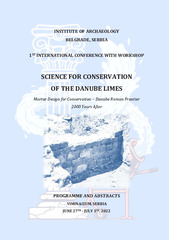Приказ основних података о документу
Contemporary approaches to the revitalisation, presentation and promotion of cultural and natural heritage of the part of the Roman Limes - Case study of the late antique tomb in Brestovik
| dc.creator | Nikolić, Marko | |
| dc.creator | Takač, Ena | |
| dc.creator | Šćekić, Jelena | |
| dc.date.accessioned | 2023-07-24T17:26:40Z | |
| dc.date.available | 2023-07-24T17:26:40Z | |
| dc.date.issued | 2022 | |
| dc.identifier.isbn | 978-86-6439-072-9 | |
| dc.identifier.uri | https://raf.arh.bg.ac.rs/handle/123456789/1304 | |
| dc.description.abstract | The Roman Limes is recognised as a cultural landscape of exceptional universal values of international importance by the relevant organisation for the protection of cultural and natural heritage - UNESCO. In the Republic of Serbia, the Roman Limes include the Danube Valley, where there are sites of different historical periods (prehistoric, ancient, medieval), which represent evidence of the continuity of life on the border of the Roman Empire. Protection, revitalisation, presentation and promotion of sites along the Danube is a prerequisite for the entry of the Roman Limes in Serbia on the UNESCO World Cultural and Natural Heritage List. From 2020, this area is on the UNESCO Tentative List. Bearing in mind the current state of a large number of localities, the question of their protection, revitalisation, presentation and promotion in a contemporary context arises. Referring to the principles of international charters and conventions, including the Document of Authenticity, the Landscape Convention and the Charter on Cultural Routes, the main goal of this paper is to spread knowledge about the possibilities of protection, revitalisation, presentation and promotion of the cultural and natural heritage of the Roman Limes in Serbia through the application of the principles defined in international charters and conventions, all for the integration of cultural and natural heritage into contemporary environment and the establishment of sustainable landscape development. The results are presented through a case study of the archaeological site of the late antique tomb in Brestovik, through the conceptual solutions of architecture students, within which the possibilities of integrating contemporary architecture into spaces of natural and historical values were examined, while preserving the identity of natural and cultural heritage that requires specific protection, presentation and promotion. Through the process of educating students of architecture, there is a possibility of the comprehensive consideration of the problem of preserving cultural and natural heritage, its historical and urban context, origin, development, cultural, urban and architectural values, and examining the possibility and comparison of different approaches to presentation and contemporary use. In designing the future approach to the presentation and inclusion in the contemporary life of the late antique tomb in Brestovik and its surroundings, the student analyses focused on comprehensive research of the life of the tomb, from its origins to modern times, as well as discovering specific cultural values that are the basis for future preservation. The goal was to design sustainable solutions that will preserve the development phases, and the authenticity and integrity of the late antique tomb in Brestovik, while ensuring its reactivation and quality integration into its environment, which, despite numerous inadequate modern interventions, has preserved elements of the recognisable historical ambiance. Through their proposals, students have filled the complex with a large amount of contemporary cultural, educational and artistic content that correlates with its character and significance, and provides it with an active life. The expected results of the research include raising awareness of the possibilities of integrating natural and cultural heritage into the contemporary context, as well as considering the natural and cultural heritage as a driver for establishing sustainable landscape development. | sr |
| dc.language.iso | en | sr |
| dc.publisher | Belgrade: Institute of Archaeology | sr |
| dc.rights | openAccess | sr |
| dc.source | Mortar design for conservation – Danube Roman frontier 2000 years after [Elektronski izvor] : programme and abstracts / 1st International Conference with Workshop Science for Conservation of the Danube Limes, Viminacium, June 27th - July 1st, 2022 | sr |
| dc.subject | Roman Limes | sr |
| dc.subject | Cultural and natural heritage | sr |
| dc.subject | Late antique tomb | sr |
| dc.subject | Contemporary revitalisation and presentation | sr |
| dc.subject | Sustainable development | sr |
| dc.title | Contemporary approaches to the revitalisation, presentation and promotion of cultural and natural heritage of the part of the Roman Limes - Case study of the late antique tomb in Brestovik | sr |
| dc.type | conferenceObject | sr |
| dc.rights.license | ARR | sr |
| dcterms.abstract | Такач, Ена; Шћекић, Јелена; Николић, Марко; | |
| dc.citation.spage | 152 | |
| dc.citation.epage | 155 | |
| dc.identifier.fulltext | http://raf.arh.bg.ac.rs/bitstream/id/4501/bitstream_4501.pdf | |
| dc.identifier.rcub | https://hdl.handle.net/21.15107/rcub_raf_1304 | |
| dc.type.version | publishedVersion | sr |

